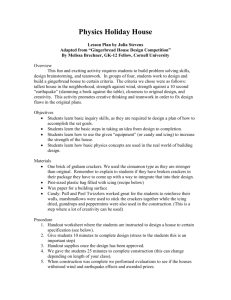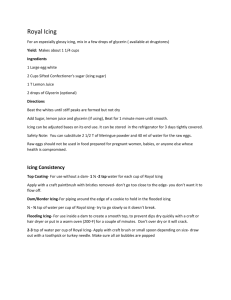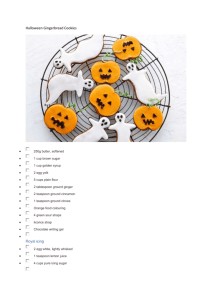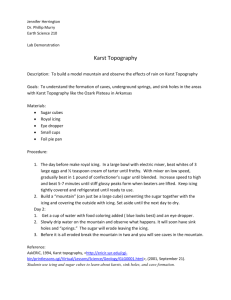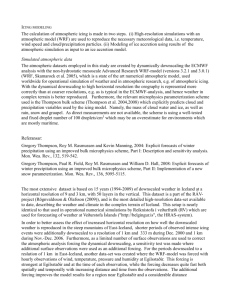The observed and parameterized icing
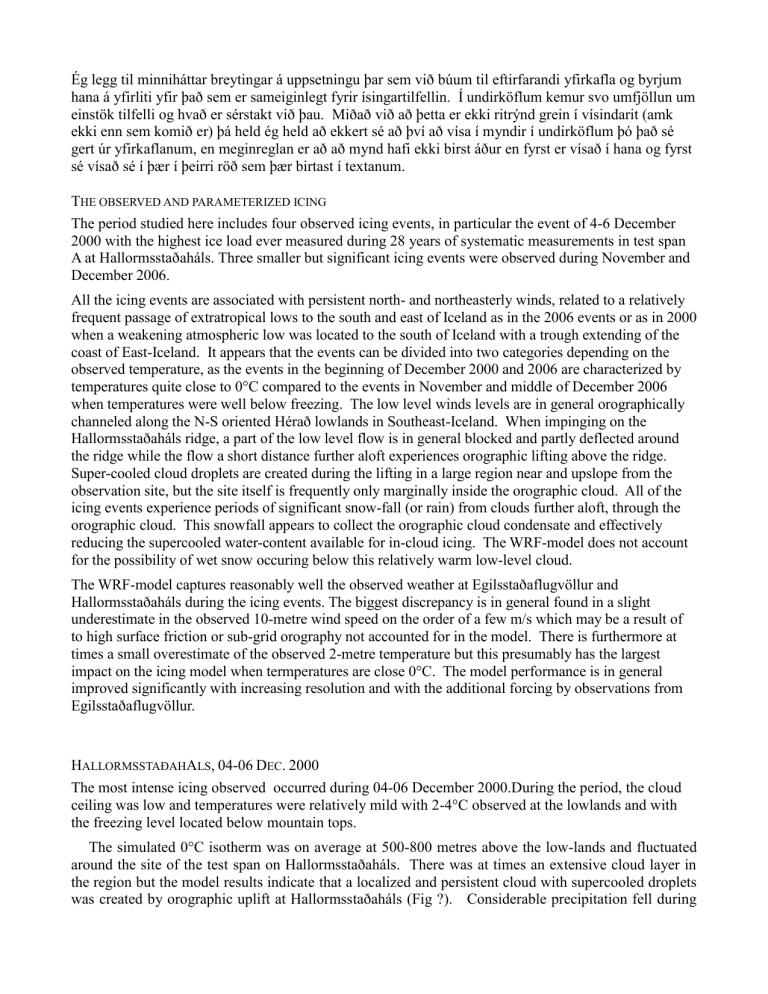
Ég legg til minniháttar breytingar á uppsetningu þar sem við búum til eftirfarandi yfirkafla og byrjum hana á yfirliti yfir það sem er sameiginlegt fyrir ísingartilfellin. Í undirköflum kemur svo umfjöllun um einstök tilfelli og hvað er sérstakt við þau. Miðað við að þetta er ekki ritrýnd grein í vísindarit (amk ekki enn sem komið er) þá held ég held að ekkert sé að því að vísa í myndir í undirköflum þó það sé gert úr yfirkaflanum, en meginreglan er að að mynd hafi ekki birst áður en fyrst er vísað í hana og fyrst sé vísað sé í þær í þeirri röð sem þær birtast í textanum.
T
HE OBSERVED AND PARAMETERIZED ICING
The period studied here includes four observed icing events, in particular the event of 4-6 December
2000 with the highest ice load ever measured during 28 years of systematic measurements in test span
A at Hallormsstaðaháls. Three smaller but significant icing events were observed during November and
December 2006.
All the icing events are associated with persistent north- and northeasterly winds, related to a relatively frequent passage of extratropical lows to the south and east of Iceland as in the 2006 events or as in 2000 when a weakening atmospheric low was located to the south of Iceland with a trough extending of the coast of East-Iceland. It appears that the events can be divided into two categories depending on the observed temperature, as the events in the beginning of December 2000 and 2006 are characterized by temperatures quite close to 0°C compared to the events in November and middle of December 2006 when temperatures were well below freezing. The low level winds levels are in general orographically channeled along the N-S oriented Hérað lowlands in Southeast-Iceland. When impinging on the
Hallormsstaðaháls ridge, a part of the low level flow is in general blocked and partly deflected around the ridge while the flow a short distance further aloft experiences orographic lifting above the ridge.
Super-cooled cloud droplets are created during the lifting in a large region near and upslope from the observation site, but the site itself is frequently only marginally inside the orographic cloud. All of the icing events experience periods of significant snow-fall (or rain) from clouds further aloft, through the orographic cloud. This snowfall appears to collect the orographic cloud condensate and effectively reducing the supercooled water-content available for in-cloud icing. The WRF-model does not account for the possibility of wet snow occuring below this relatively warm low-level cloud.
The WRF-model captures reasonably well the observed weather at Egilsstaðaflugvöllur and
Hallormsstaðaháls during the icing events. The biggest discrepancy is in general found in a slight underestimate in the observed 10-metre wind speed on the order of a few m/s which may be a result of to high surface friction or sub-grid orography not accounted for in the model. There is furthermore at times a small overestimate of the observed 2-metre temperature but this presumably has the largest impact on the icing model when termperatures are close 0°C. The model performance is in general improved significantly with increasing resolution and with the additional forcing by observations from
Egilsstaðaflugvöllur.
H ALLORMSSTAÐAH A
LS
, 04-06 D
EC
.
2000
The most intense icing observed occurred during 04-06 December 2000.During the period, the cloud ceiling was low and temperatures were relatively mild with 2-4°C observed at the lowlands and with the freezing level located below mountain tops.
The simulated 0°C isotherm was on average at 500-800 metres above the low-lands and fluctuated around the site of the test span on Hallormsstaðaháls. There was at times an extensive cloud layer in the region but the model results indicate that a localized and persistent cloud with supercooled droplets was created by orographic uplift at Hallormsstaðaháls (Fig ?). Considerable precipitation fell during
the period, both as rain and snow near the test span. The lowering of the isotherms near
Hallormsstaðaháls may at times be associated with significant evaporative cooling but it is also a result of the upstream blocking of the low-level flow. The variations in the locations of the 0°C isotherm and the cloud condensate near the site of the test span have a strong impact on the parameterized icing.
Considerably greater icing may be parameterized for a location slightly further upslope from the testspan than at the site itself, as is evident from the section in Fig. ?.
( Kannnski má færa síðustu málsgrein (setningu) aftan við í konklúsjónina? Hún er almenn og gildir til jafns fyrir hin tilfellin. )
H ALLORMSSTAÐAH A LS , 13-30 N OV .
2006
The icing event during 12-30 November 2006 can be split into three sub-periods of intense icing.
Temperatures are well below zero during the period and there is significant orographic uplift above
Hallormsstaðaháls with the creation of large amounts of super-cooled cloud-condensate near and above the observation site. As for the other events there is during the first and third sub-period of intense icing, large scale snowfall through the orographic cloud. The second sub-period is characterized by high amounts of condensate above and near the test span, while the site itself is at times just outside the region.
H ALLORMSSTAÐAH A
LS
, 04-12 D
EC
.
2006
The atmospheric simulations during the icing period of 3-11 December are characterized by significant rainfall and higher temperatures at the beginning than at the end of the period when temperatures have decreased and there is some snowfall. The large scale and orographic clouds in the region contain mostly supercooled cloud condensate, and it appears that the rainfall from them can be associated with freezing rain at higher altitudes but this remains to be investigated more closely.
H ALLORMSSTAÐAH A
LS
, 14-21 D
EC
.
2006
During 12-19 December temperatures are well below zero and the low level flow is mostly blocked and deflected around Hallormsstaðaháls. However, the flow above experiences orographic uplift above
Hallormsstaðaháls with significant and variable amounts of super cooled cloud water condensate near and above the location of the test span, with the maximum amount on average located a short distance upslope from the observation site.
